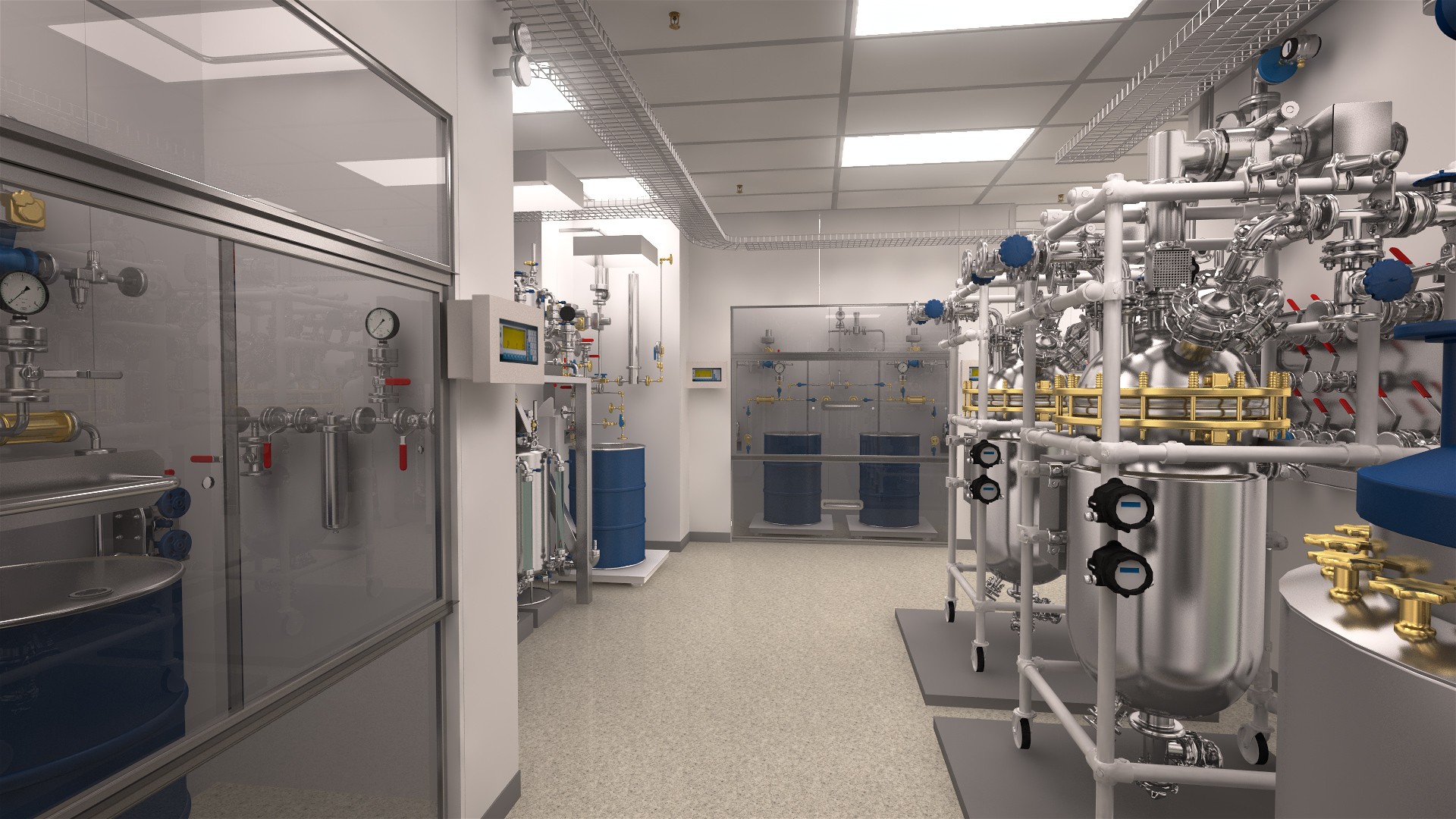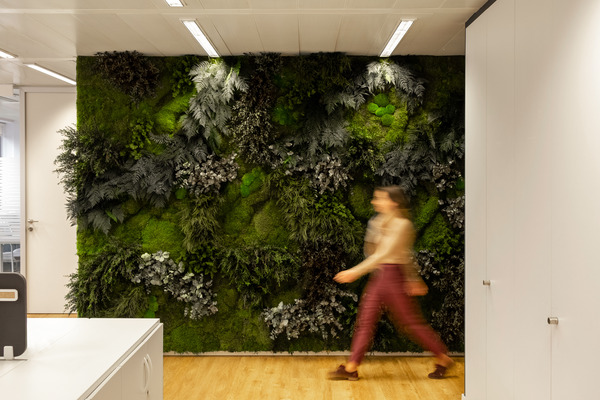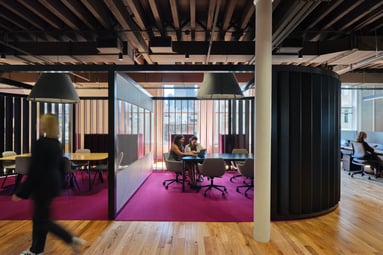14 trends impacting life sciences design and construction in 2024

We asked our life sciences experts from across the globe to weigh in on trends, research, and innovations that they believe will impact and shape facility and space design in 2024 and beyond.
It’s no surprise the life sciences industry is continuing to experience high levels of demand, requiring new, innovative ways of working, agile strategies and forward-thinking methodologies. To not only maintain the status quo but accelerate to keep up with a rapidly evolving market, our experts are seeing a shift in how life sciences spaces are designed and emerging focuses from life sciences companies.
This outlook is a response to the top priorities of our clients and how life sciences design can impact future advancements in the industry.
Don’t have time to read the full article? Access the full outlook here.
1. What trends are on their way “out” from 2023, and what’s “in” for 2024 and beyond?
“Transitioning away from outdated modular pods and silos, the future of life sciences is embracing friendly collaborative ecosystems that foster innovation in labs and workplace environments. Ethical AI, personalized medicine, and sustainable design solutions will continue to define and shape the future of life sciences innovation.”
– Bobby Savarese, Senior Principal, Life Sciences
Pro tip: Collaborative ecosystems and office-to-lab conversions will continue to shape construction for life sciences.

2. What are the latest research trends in life sciences design, and how will they impact space design?
“In life sciences research, the dominant trends are in cell & gene therapies (CAR-T, stem cell, gene editing), followed by modalities like proteins & peptides and nucleic acids. These advancements necessitate flexible and reconfigurable CL2/BSL2/PC2 laboratories. In the UK, there’s a growing demand for genomics and diagnostics laboratories in healthcare settings.
Clinical-stage biotechs present opportunities for advanced manufacturing with GMP-compliant facilities. The convergence of Artificial Intelligence (AI), data science, and quantum computing will significantly impact drug discovery, manufacturing processes, and clinical research in 2024 and beyond.”
– Manisha Kulkarni, PhD, MBA, Director of Science & Technology
Pro-tip: Pioneering therapies, talent attraction and retention, and seamless technology integration will propel the evolution of future-ready spaces.
3. What new innovations will we see in life sciences and science & technology design and delivery in 2024 and beyond?
“With the rapid advancements in technology, I expect to see an increased demand for flexible spaces that are more easily reconfigurable to meet the changing needs of laboratory users.”
– Sam Gill, Head of Life Sciences, ANZ
Pro-tip: Cutting-edge advancements in life sciences will usher in bioengineering revolutions and seamless technology integration.
4. How do organizations need to evolve to meet future demands and innovations within the life sciences industry?
“Life sciences design and build organizations must evolve by prioritizing innovation, adopting cutting-edge technologies, and fostering collaboration. The industry will undergo changes in regulatory requirements, with clients dedicated to sustainability. Project implementation will need to adapt to these future demands and transformative innovations.”
– Bobby Savarese, Senior Principal, Life Sciences
Pro-tip: To meet future demands in life sciences, organizations must prioritize innovation, adopt cutting-edge tech, and foster collaboration.

5. How will the “AI” and “data science” buzzwords affect the life sciences industry and lab design in 2024 and beyond?
“Incorporating AI into research development is crucial, especially in areas such as formulation and research related to long-term stability. The utilization of AI, along with large-capacity data storage, enables the retention of historical data and provides lightning-fast access to specific information. This allows lab users to streamline processes, eliminating the need for time-consuming and space-consuming exercises, and ensuring timely access to historical data without unnecessary replication.”
– Steven Ritchie, Principal, Life Sciences
Pro-tip: Adaptability and optimization will drive the future of laboratory design and construction.
6. How might AI and data science be seen differently in large-scale pharma and small biotechs?
“AI and data science are poised to revolutionize various aspects of human life, and their impact on the life sciences industry is undeniable. The two crucial factors, namely funding and the availability of the right skills for implementation, play a pivotal role in successfully integrating AI and data science into research and development (R&D) and manufacturing processes.
Both large pharma and small biotechs recognize the transformative potential of AI and data science; the disparity in available resources and organizational maturity often leads to distinct approaches. Large pharma engages in extensive digital transformation initiatives, leveraging their robust financial positions and skilled workforce, while small biotechs, constrained by resources, may opt for more cautious and targeted adoption of these technologies.”
– Manisha Kulkarni, PhD, MBA, Director of Science & Technology
Pro-tip: Integration of AI and data science depends on organizational maturity and resource availability.
7. What will be the potential impact of technological advances on life sciences mechanical and electrical services throughout 2024 and beyond?
“With the surge in energy consumption posing challenges to the global energy industry and resulting in environmental damages, it is crucial to enhance energy efficiency in labs and data center facilities. Waste heat recovery technology emerges as a promising solution, aiming to improve energy efficiency, realize cost savings, and address environmental impact issues associated with carbon emissions and waste heat discharge simultaneously. The harnessed recovered energy can find applications in various areas such as internal heat supply, selling energy back to regional power and energy distribution services, internal cooling, and electricity production.”
– Steven Ritchie, Principal, Life Sciences
Pro-tip: Incorporate waste heat recovery technology to optimize energy.
8. What challenges will the life sciences industry face in 2024?
“The life sciences industry faced funding setbacks in 2022-2023, impacting its transformative potential. While poised for positive strides in 2024, the sector could encounter challenges related to macro-environmental factors, evolving biologics manufacturing, scarcity of skilled professionals in emerging (cell & gene therapy) fields, and the need for compliant, purpose-built facilities, especially in the UK. Tackling these issues is pivotal for ensuring the sustained growth and resilience of the life sciences sector.
One of the challenges in laboratory design and delivery is a need for more skilled personnel who understand lab user and regulatory requirements and translate them into construction specifications.”
– Manisha Kulkarni, PhD, MBA, Director of Science & Technology
Pro-tip: Addressing space scarcity, the talent shortage, and getting facilities to market quicker is key to ensuring sustained growth.

9. What can life sciences companies do to deliver their projects faster in 2024?
“An integrated design and build approach not only expedites the design and construction process for life sciences companies, but it also provides greater visibility compared to the traditional approach. The result is quite frankly a cleaner project with faster occupancy that enables companies to bring their products to the market sooner.”
– Damian Besculides, AIA, NCARB, Senior Principal
Pro-tip: Get products to market sooner with an integrated design and build approach.
10. What are the top things that landlords need to be able to provide to support the emerging trends in science & technology?
“For landlords developing life sciences spaces, the critical factor is flexibility and adaptable lab spaces that can handle most development plans and adapt to change. Given the rapid evolution of technology, often outpacing scientific advancements, these spaces must be designed to accommodate this dynamic landscape.”
– Damian Besculides, AIA, NCARB, Senior Principal
Pro-tip: Life science design should ensure spaces are adaptable and flexible.

11. To what extent should landlords fit-out to attract life sciences tenants?
“The research goals of life sciences clients are ever-changing, leading to evolving space requirements. Our advice is to design schemes that are ‘lab ready,’ incorporating ample power, plant space, waste management, laboratory gases, liquid nitrogen provisions, re-configurable benching, and flexible services. However, we recommend steering clear of fully fitted and tailored solutions until a specific tenant has been identified. This approach ensures adaptability to diverse research needs while avoiding unnecessary constraints.”
– Manisha Kulkarni, PhD, MBA, Director of Science & Technology
Pro-tip: Offer “lab ready” spaces with re-configurable benching and flexible services.
12. What meaningful initiatives can businesses take to enable sustainability best practices in energy-intensive R&D facilities?
“It is a well-known fact that lab and manufacturing spaces are some of the least sustainable environments. However, Architects and Engineers are currently exploring technologies that will allow facilities to harness the heat loads generated by lab and manufacturing infrastructure.
Some technologies used to reduce waste are recirculating air systems in lieu of 100% single pass air systems. This technique involves extensive filtration systems; and while it saves energy, it may require inordinate amounts of maintenance. This technique is usually used in low-risk or low-contaminant environments."
– Steven Ritchie, Principal, Life Sciences
Pro-tip: Consider recirculating air systems and/or shared functions to save energy.

13. Where will be the focus in 2024 investment for sustainability for life sciences companies to reach their sustainable development goals?
“The focus for sustainability investment in the life sciences sector in Australia may differ from the emphasis seen in EMEA and the US. However, established companies with larger facilities are continuing to prioritize roof-mounted solar panels as a relatively easy and effective means to achieve greater sustainability.”
– Sam Gill, Head of Life Sciences, ANZ
Pro-tip: Sustainability approaches differ based on size and location.
14. What can life sciences companies do to attract talent in 2024?
“To become an employer of choice, some of the things life sciences companies should consider are creating world-class laboratory facilities that reflect the cutting-edge nature of the industry and global connectivity and transport links to recognize the importance of global citizenship. They should also ensure that laboratory facilities are well-connected, not only in terms of technology but also supporting physical accessibility and the emphasis on work-life balance—acknowledging the post-pandemic shift in priorities, with researchers placing increased emphasis on work-life balance.”
– Manisha Kulkarni, PhD, MBA, Director of Science & Technology
Pro-tip: Listen to employees’ needs to create authentic and cutting-edge spaces that support employees to thrive.
Interested in learning more? Download all of the insights to uncover what our life science design experts have to say on these questions.


